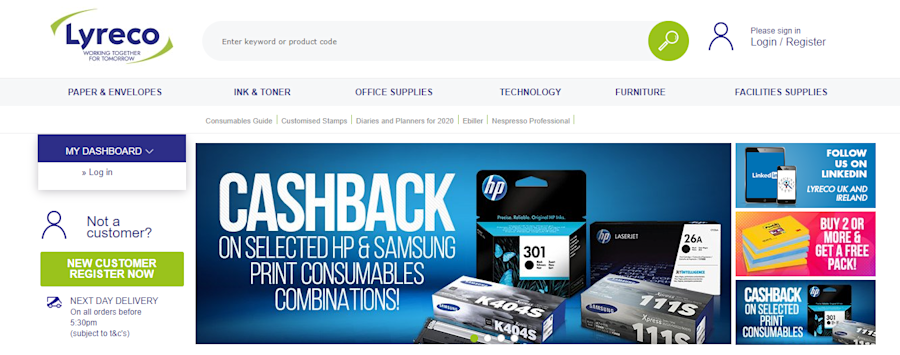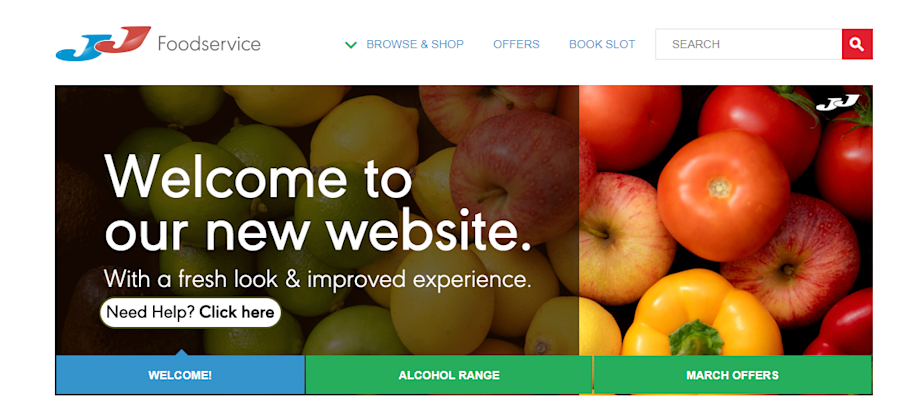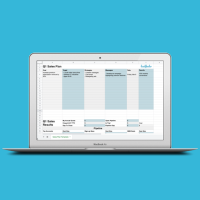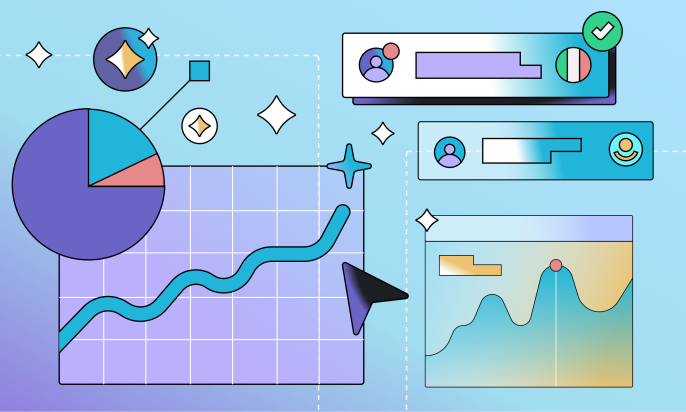B2B sales in e-commerce in the US are projected to hit $3.1 billions by 2027.
In comparison, the revenue from B2C e-commerce sales is only estimated to reach $1.7 billion by the same year.
A strong understanding of the differences between B2B and B2C sales is essential for achieving B2B success. Investing in sales tactics that have been proven to work is also essential.
Luckily, we have everything you need to know right here in this one article. Read on to explore the definition of B2B sales, understand the B2B sales process, and uncover the best practices that will help you avoid common B2B challenges.
Note: Want to know what businesses are visiting your website? Leadfeeder will tell you. Try it free, we'll show you who visited your website and which pages they visited.
What does B2B sales mean?
B2B sales, or business-to-business sales, are when companies sell products or services directly to other businesses. Because businesses tend to buy in bulk and invest heavily in services, these sales often involve large orders.
Due to this, the typical process of securing a B2B sale is long and complicated, requiring sign-off from numerous decision-makers and/or a long-term trade commitment.
B2B sales vs. B2C sales: What’s the difference?
B2C sales are made directly from a business or salesperson to the consumer. Unlike B2B sales, they’re usually smaller in scale and involve only the consumer’s decision.
Common business-to-consumer sales examples include:
A sales rep at a car dealership.
An online eCommerce store that sells clothes.
A supermarket selling a variety of consumables.
Compared to B2C, B2B businesses have a bigger pool with larger fish, greater targeted marketing opportunities, and, of course, more expansive budgets.
So, why is there such a drastic difference between B2B and B2C sales?
Higher average transaction value
While the B2B sales pipeline can be small, like an SMB making an order of office supplies, it can often stretch to thousands or millions of dollars and involve a massive supply chain.
Outside of a few specific B2C industries—such as real estate, automotive, and luxury goods—this isn’t the case.
Longer sales cycles
Excluding the three B2C industries mentioned above, B2C consumers base purchasing decisions on emotions and quick, fleeting needs—a phone case, clothes, or edible goods, for example.
B2B buyers, however, are often looking for a concrete ROI, a measurable edge, or a logical solution to a specific problem. The B2B industry uses CRM software just to keep the sales funnel in order.
They must also win the approval of numerous decision-makers.
Multiple stakeholders
In B2B sales, each decision influences the business’s bottom line, and purchase decisions climb a ladder of approval.
This means a mutual “yes” from all decision-makers precedes a successful sale. The higher the value of the deal, the greater the number of “yeses” needed.
Educated buyers
B2B buyers exercise extreme selectivity. Not only are they picky about who they do business with, but they’re also developing their own purchase criteria without the aid of salespeople.
This is why content, like case studies, for example, has become such an important part of the B2B sales process—cold outreach just doesn’t do the trick anymore.
What are the main B2B sales examples?
Depending on the sales model, B2B sales come in three different types:
Type 1: Supply sales
The business owner, or supplier, sells consumables that support another business. This includes office supplies, employee workwear, and equipment.
They have a similar process to B2C businesses. The difference, however, lies in quantity and purchase authorization.
Instead of one person buying a single ink cartridge, an employee will buy 50 ink cartridges and need approval from a manager or decision-maker for the purchase.
Lyreco, a large retailer of office and equipment supplies, is an example of a company specializing in B2B transactions of this type.

Type 2: Wholesale/distribution sales
The wholesaler sells key manufacturing or retail components to other businesses—think raw materials.
JJ Foods is an example of a wholesale food distributor. They sell essential food products to restaurants and fast food outlets that then serve products at a marked-up price to customers.

Type 3: Service/Software sales
The service provider sells a service instead of a product, commonly SaaS sales tools.
Using tax accounting as an example, this could be an accountant who consults with a small business or an accountancy firm working with a larger business.
It could also be a service provided via software—like tax accounting software, QuickBooks.

What is the B2B sales process?
While the average B2C sale can be achieved with some advertising, a solid brand and/or a low price tag, a B2B sale requires a more complicated and lengthy process.
That might sound intimidating, but the good news is that you don’t need to worry about every part of the process at once.
Take it step by step and you’ll have a much easier time. Just give your current step your full attention, and once you’re happy with it, move on to the next.
Here’s a breakdown of the essential steps in the B2B sales process:
Lead generation
Forget the approaches for lead generation that work for B2C. B2B shoppers are more discerning, with specific requirements that often are only met by niche industries. If you want to get their attention, you need to target them with pinpoint accuracy.
Tools like content marketing, SEO, social media outreach, and in-person networking can really pay off here—but only if you use them creatively and consistently after carefully thinking about the people you want to reach.
If you’ve never used buyer personas, now’s the time to change that. You can’t hope to maximize the impact of your lead generation budget if you’re putting resources toward marketing to the wrong people.
Once you know the right people to target, you can start thinking about where you can find them and where they’ll be most receptive to your messaging.
Workshop your marketing tactics, project brand quality, and continue to listen to what your audience has to say so you can cater your value proposition accordingly. Sooner or later, that will result in leads.
Lead qualifying
No matter how finely you tune your marketing, your net will drag in some fish you weren’t expecting—and the sooner you throw them back in the water, the better.
Any time you spend on a prospect lacking the desire, budget, or authority to purchase your product is wasted.
The easiest way to filter out unqualified leads is to ask the right questions right away. You do this through a website sign-up form or an initial consultation.
Ask about budgets, long-term aspirations, brand intentions, and specific requirements. If the answers don’t pass muster, move on.
A word of caution, though: if a prospect is close to qualifying, perhaps having the interest and the right brand but not the necessary budget, don’t throw the lead away.
Instead, put it on the back burner. Give it a while, and reach out to them again down the line. If nothing has changed, no harm. But if their budgeting situation has changed for the better, you can jump on the opportunity.
Prospect engagement
Once you've qualified your lead, it's time to start building a connection.
Since B2B buys often result in long-term associations (in fact, they frequently require the establishment of stable working relationships), the prospect will probably be trying to decide whether your business is worthy. Show them that you are.
OK, that’s easier said than done, so let’s get into some tips. Most vitally, you need to show that you understand what they’re looking for and why. If you can’t manage that, they won’t trust that you can solve their problems.
Next, you must demonstrate a solid awareness of their company. What does it offer? What are its pain points?
Take the time to do some research into the company in question, and follow it up by being inquisitive. If you can show that you listen closely because you want to exceed expectations, you’ll set a positive precedent.
In addition, offer them value where possible. Business suggestions, marketing feedback, and introductions to industry contacts can all work well.
Does this take up time and resources for a lead that isn’t guaranteed to pay off? Sure. But that’s a great risk to take, because winning their approval and trust has the potential to return incredible value across a long period of time.
Product demo
This could also be a service demo, of course. Whether it’s a product or a service, you need to give prospects every reason to discover why it’s exactly what they need.
Arrange a demonstration at a suitable time, but don’t make the classic mistake of listing off features. The prospect is looking for you to solve a problem for them, so focus on how you can do that.
Draw from the understanding of the prospect that you built up in the previous step when planning your demo. The tried-and-tested formula is simple; list the pain points, delve into what makes them so frustrating, then, cue your solution.
If possible, reinforce your case with positive customer testimonials that prove the real-world impact of what you’re offering. If not, find another way to prove that you’re not full of hot air. After all, anyone can make big promises.
Remember not to push too hard—you don’t want to come across as desperate. Make your case succinctly, answer any questions, and give your prospect time to think. This isn’t a process you can rush, so settle in for the long haul (and possibly multiple demos).
Deal closing
If you’ve successfully demonstrated your product or service to the prospect and anyone else from their company who’s influencing the decision, you should have sparked some eagerness, but that alone won’t seal the deal.
It’s time to start talking about terms. Landing a B2B sale is so complicated because the delivery phase can be tricky. If you’re offering products, when can you provide them? If you’re offering a service, when will it become active?
Each party may want to look for some concessions during the discussion. Perhaps you’re hoping to start sooner than they initially hoped to, or maybe they’re hoping to get some last-minute add-ons to the deal you originally put on the table.
Make an effort to be as transparent and flexible as you can. If you can’t hit a deadline, be clear about that. If you can change a part of the deal to accommodate them, make it happen. You want to start on a positive note.
This is a tough step to get right because you need to find the right balance between pushing the sale and showing patience. If you’re too pushy, you might ruin the deal, but if you’re too passive, they might keep pushing it back.
Do your best using everything you’ve learned about them, and you should be able to get the deal over the line, marking the beginning of a valuable partnership.
Customer support
As you’ve surely inferred from all the previous steps, wrapping up the sale isn’t the end of the process. You’ve begun a working relationship that could be a huge boost to your business, and that relationship must be maintained and cultivated.
Post-sale support in the B2B world is a big deal because keeping an existing customer is vastly more economical than finding a new one. That’s true in B2C, of course, but the gulf is even bigger in B2B.
Starting with making the onboarding process as smooth as possible, you should look to do everything you can—within reason—to help your new customer get great results with your products and/or services.
Offer tips, aid training, and keep up your willingness to listen to complaints, queries, and even social calls. Being friendly with your customers might not be absolutely vital, but it’s a strong advantage in B2B sales.
By keeping up the quality of your customer support, you’ll prevent minor issues from snowballing into serious threats to the working relationship. You’ll also earn plaudits and positive recommendations you can use for future demos. A happy customer is one of the most powerful marketing assets you can have.
What are the challenges of the B2B sales experience?
As you’ve surely inferred from all the previous steps, wrapping up the sale isn’t the end of the process. You’ve begun a working relationship that could be a huge boost to your business, and that relationship must be maintained and cultivated.
Post-sale support in the B2B world is a big deal because keeping an existing customer is vastly more economical than finding a new one. That’s true in B2C, of course, but the gulf is even bigger in B2B.
Starting with making the onboarding process as smooth as possible, you should look to do everything you can—within reason—to help your new customer get great results with your products and/or services.
Offer tips, aid training, and keep up your willingness to listen to complaints, queries, and even social calls. Being friendly with your customers might not be absolutely vital, but it’s a strong advantage in B2B sales.
By keeping up the quality of your customer support, you’ll prevent minor issues from snowballing into serious threats to the working relationship. You’ll also earn plaudits and positive recommendations you can use for future demos. A happy customer is one of the most powerful marketing assets you can have.
What are B2B sales strategies that work?
The problem with the B2B sales cycle isn’t a shortage of strategies and tactics; it’s that there are too many sales enablement options.
Should you create videos?
Create extensive research white papers?
Run PPC ads?
Do more email marketing?
The best B2B sales strategies are buyer-centric. They’re designed with the modern B2B sales process and savvy buyers in mind. Here are the top three Leadfeeder choices:
1) Account-based sales
The days of siloed B2B sales and marketing teams are gone.
The line that marks the difference between bringing users into the funnel and keeping them in the funnel is no longer a line.
It’s more of a Venn diagram—roles and responsibilities remain interconnected and often cross paths.
But, marketing and sales don’t always agree, and this misalignment damages the productivity of B2B salespeople.
By focusing on target accounts, account-based sales (ABS) flips the typical funnel on its head and encourages sales and marketing to collaborate.
Just like the beginning of the B2B buyer journey, an ABS approach starts with a solution that the buyer is searching for and that the company knows it can solve.
This means sales and marketing must agree on who the decision-makers are and how to present a personalized solution to the problem buyers are looking to solve.
2) Content marketing
According to CMI, 84% of B2B marketers use content marketing to create brand awareness, and it’s easy to see why.
Content bridges the gap between buyer and seller. It tilts the purchase decision in favor of the vendor.
But, effective content isn’t just about sharing news about your company’s office pet. It’s about solving problems to build a connection, establish trust, and bolster brand credibility.
Powered by content marketing, HubSpot, our integration partner, has grown rapidly from a start-up to a company with a revenue of over $2 million.

Their results are far from anomalous. In 2020, Mailshake completely changed its fortunes with a well-planned content strategy.
3) Social selling
Social selling is the modern way for B2B sales reps to not only build relationships but also close deals before competitors have a clue what’s going on.
Relying on conference lists to find new leads, New Horizons found that ROI was starting to dwindle.
Sales were dropping because leads were close to a buying decision by the time reps reached them.
To rescue declining sales, they needed to get on buyers’ radars at an earlier stage.
Social selling on LinkedIn became their winning solution. In the end, sales reps gained 1.7M worth of opportunities in 6 months, a 57% close rate, and $1M in revenue.
Social selling was so effective at generating leads that the COO created a “social hour,” reps now spend an hour of their day researching and connecting with leads on LinkedIn.
What is the future of B2B sales?
Though the basic nature of B2B selling doesn’t change much, it’s undeniably true that we’re seeing some big shifts in how B2B sellers build and execute their sales funnels, so it’s worth thinking about what the future holds.
In all likelihood, B2B selling in the future will be different in two core ways:
It’ll be adaptively omnichannel. In other words, all the marketing and sales materials will automatically be tweaked to fit all relevant communication channels. Instead of writing emails and social media posts, a marketing professional will write a central repository of copy that’s used for everything.
AI-led tools will enable sales teams to be more detail-oriented than ever, allowing them to personalize interactions more effectively and find fresh ways to streamline their processes. This will give skilled salespeople more opportunities to focus on in-person meetings where they can really shine.
The common theme here, of course, is the rising influence of AI-driven technology. And, while some salespeople are fearful of what it can do, we are confident it won’t replace them. Instead, it’ll enhance what they can do and complement their talents.
Streamline your B2B sales process with Leadfeeder by Dealfront
So, what is B2B sales going to look like for you now? The B2B sales process isn’t linear anymore. Instead, it’s better to think of it as an overlapping Venn diagram that’s populated with multiple touchpoints, pain points, and value-oriented buyers.
Although some may think of this change as a cause for concern, in reality, it’s an improvement. A complicated sales process equals a higher barrier to entry, which can only be a good thing.
It means that buyer-centric B2B companies will be rewarded with more sales, whereas outdated companies that don’t adapt will be left in the dust.
With Leadfeeder by Dealfront, you can pinpoint and target the companies already visiting your website for high-value, data-backed B2B leads.
Want to know more? Try Leadfeeder for free, we'll show you who visited your website and which pages they visited.
B2B sales FAQs
What is B2B sales’ first step?
The first step in B2B sales is lead generation. This involves identifying potential customers that may be interested in your product or service and gathering their contact information so that you can reach out to them.
What is the role of data in B2B sales?
Data can best support B2B sales by helping sales teams pick out the best possible leads and giving them valuable insight into customer behavior. The latter is particularly significant because understanding customers is key to keeping them, and keeping B2B customers is a mission-critical concern.
What are the three main types of B2B sales?
The three main types of B2B sales are as follows:
Supply sales: These involve consumable items or items of equipment necessary for business operations. Examples include catering food, office supplies, business laptops, and generator fuel.
Wholesale/distribution sales: These involve bulk products that the buyers then sell on to consumers. Examples include grocery items, toys, notepads, and consumer electronics.
Service/software sales: These involve services or software solutions that typically help buyers do their jobs more productively and/or efficiently. Examples include business growth consultations, account audits, and cloud-based tools.
Now that you're here
Leadfeeder is a tool that shows you companies that visit your website. Leadfeeder generates new leads, offers insight on your customers and can help you increase your marketing ROI.
If you liked this blog post, you'll probably love Leadfeeder, too.
Sign up








